
Guests
- Laila El-HaddadPalestinian journalist and mother living in Gaza. She writes for Aljazeera.net. She maintains her own blog, “Raising Youssef: A Diary of a Mother Under Occupation.”
We turn now to Gaza where at least 20 Palestinians were killed Wednesday in fierce internal fighting between the two main factions Hamas and Fatah. As many as 45 people have died with more than 100 wounded in four days of violence. [includes rush transcript]
Transcript
AMY GOODMAN: We turn now to a crisis that is continuing to gather steam in the Middle East. Juan?
JUAN GONZALEZ: Yes, we’re talking about Gaza, where at least 20 Palestinians were killed Wednesday in fierce internal fighting between the two main factions, Hamas and Fatah. As many as 44 people have died, with more than 100 wounded, in four days of violence.
The rival groups agreed to their fourth truce in as many days Wednesday in a bid to stop the fighting. The truce has appeared to take hold, as President Mahmoud Abbas of Fatah is due to travel to Gaza for talks with Hamas Prime Minister Ismail Haniyeh.
Meanwhile, Israel carried out airstrikes on Gaza, killing at least four Palestinians. Israeli Prime Minister Ehud Olmert ordered a “severe response” after Hamas fired rockets into Israel, injuring four Israelis.
AMY GOODMAN: Laila El-Haddad is a Palestinian journalist and mother living in Gaza. She writes for a number of publications, including aljzeera.net and The Guardian of London. She maintains a blog called “Raising Youssef: A Diary of a Mother Under Occupation.” She joins us now from Gaza.
Can you describe the situation right now, Laila?
LAILA EL-HADDAD: Yes, absolutely. I mean, right now it’s — in Gaza City, at least, it’s calm, relatively, with just sporadic gunfire. And I’m currently — I just went south to work to Rafah in the southern Gaza Strip, where there were some clashes that broke out and, again, sporadic gunfire, but nothing like the past, what we witnessed the past two days, when I was in Gaza City and literally holed into our living room for two days, unable to move.
And it was particularly dangerous for people just a block down, where snipers had taken position on high-rise towers throughout the city that were populated with either residents or offices. And you had also gunmen, you know — and you could never quite tell which side it was — but patrolling the streets and at set-up sort of impromptu checkpoints, stopping cars, harassing and intimidating shopkeepers, of course, which, you know, very few were open, maybe one or two. But Gaza was literally transformed into a ghost town, and the civilian life was completely paralyzed yesterday.
JUAN GONZALEZ: And what are you able to tell in terms of the Israeli actions or involvement, in terms of the continuing conflict between Fatah?
LAILA EL-HADDAD: Between the what? Sorry, I didn’t hear what you said.
JUAN GONZALEZ: I’m sorry. What are you able to tell in terms of the Israeli involvement in the conflict?
LAILA EL-HADDAD: Right. Of course, I mean, you know, people here are very perturbed and upset at what’s happening locally and place a lot of blame on the organizations themselves or the members or whoever is doing the shooting, but at the same time look at it within the larger context of the continuing Israeli occupation, the continuing Israeli siege of Gaza and, of course, the continuing global boycott of the Palestinian government and, even now, the Palestinian unity government, and taking a step further and seeing that there’s something far more sinister behind it all, particularly the U.S. agenda to see the downfall of the unity government through arming, of course, and training Mohammad Dahlan, the Fatah strongman in Mahmoud Abbas’s security forces.
AMY GOODMAN: Laila El-Haddad, we got information yesterday about a group of reporters who were caught in a burning building, reporters from Al Jazeera and other news organizations, in Gaza. Can you describe what was happening to them?
LAILA EL-HADDAD: Absolutely. That building is literally a block and a half down from my own, and we were sort of in the eye of the storm. Everything was twirling around us. And so, we could certainly hear that happening and then saw that live, as well, on Al Jazeera and other organizations. But it’s a media building that houses several different media outlets, including the BBC, the local news agency Ramatan, and Al Jazeera. And snipers had taken position on that tower, because it’s a high-rise, and so the journalists were holed up into one of the rooms and had taken shelter there for possibly an hour or more, while gunmen exchanged fire, until they were finally released, and then the sort of tenuous ceasefire took hold later that night.
So it was certainly something that affected everyone, journalists included, and it was quite — I mean, in my experience being here, it had never gotten that bad, ever, in terms of completely paralyzing civilian life, where everybody literally was a moving target. And, you know, many people I’ve spoken to here say this — I don’t know if you can hear that, but I’m in Rafah, and there’s sort of sporadic gunfire in the background here, where clashes have broken out. But I was going to say, people I’ve spoken to have said their feeling is that their sense is if things start up again, they really don’t think there’s going to be a way out next time. And that’s why it’s, I mean, all the more important. I mean, I constantly refer to, you know, Gaza bleeding and Gaza burning as the world is watching, just because I feel it’s so purposeful. It’s happening with such purpose, and yet with so little protest.
JUAN GONZALEZ: What about the basic needs of the population — water, electricity, the basic utilities? Do they continue to function while the fighting is going on?
LAILA EL-HADDAD: Several Gaza City neighborhoods were plunged into darkness when electricity cables were shot down, rather, and the electric company could not reach the generators to fix them. So there were certainly two neighborhoods that had lost electricity for two days and still don’t have electricity today.
You know, food and supplies, insofar as — you know, people had access to what they had in their houses, but certainly not the shops, which have closed down. Many people had stocked up on bread, for example, fearing that it was something that could continue for several days and limit their access to shops and foodstuffs. Blood was certainly on short supply, and so was x-ray film in all of the major Gaza hospitals, as reported by the World Bank.
JUAN GONZALEZ: And also, there was a report that there was a protest yesterday of some residents who were calling for an end of the fighting between the two groups. Is there any indication —
LAILA EL-HADDAD: There was a what? Sorry?
JUAN GONZALEZ: There was a report in the U.S. press here that there was a protest yesterday of some residents who were calling for an end to the fighting between the two groups. Are there any indications —
LAILA EL-HADDAD: There was. In the morning, there was. It wasn’t so much yesterday as the day before and this morning, but very small and isolated. I mean, really, you have to understand, people were so afraid for their lives they didn’t even dare get near the window, let alone outside the house. So the day before yesterday, there was a small group of people that had gone out to protest, saying that our — to coincide with the 59th anniversary of al-Nakba, which is the day — you know, the catastrophe, the day Palestinians mark when Israel was declared on 78 percent of historic Palestine. They were saying our Nakba has now become two Nakbas. And now, people are referring to this, you know, infighting as their second Nakba.
AMY GOODMAN: And the reports that the U.S. is arming Fatah?
LAILA EL-HADDAD: Yes.
AMY GOODMAN: Can you elaborate on that?
LAILA EL-HADDAD: Yeah, I mean, it’s — again, it is no hidden agenda. It’s not any kind of conspiracy. It’s something that’s been very open and reported openly in the press, but again, the media has chosen not to necessarily concentrate on this particular aspect.
Over the past, I think it might have been, two years or so, especially, particularly in the period right before the elections, the U.S. began funding Mohammad Dahlan, specifically, personally, in hopes to stave off a Hamas election victory, and then, following the election victory, Hamas’s election, continued to fund both Mohammad Dahlan and Mahmoud Abbas, the security forces, and training and arming them, as well. And the sum has reached something to the effect of $84 million.
And just a day ago, when the latest clashes began, in fact, Israel authorized the opening of Rafah crossing, which is closed — the only civilian passage in and out of Gaza, and it’s closed at least 50 percent of the time, according to the U.N. But they authorized that to be open specifically to allow the entry of at least 450 members of the Badr Brigades, which is the elite Fatah brigades that were trained in Jordan with U.S. funding. So again, it’s very clear and out in the open. And just about a week or two ago, the plan was elaborated on in a Jordanian newspaper, before being whisked off the presses — again, the latest plan to arm and fund and try to overthrow or see the downfall, at least, of the unity government.
AMY GOODMAN: And the reports that Israel is planning to reoccupy Gaza?
LAILA EL-HADDAD: Those — I mean, people here don’t seem to find much veracity in those claims, and I don’t think Israel [inaudible] something. I mean, they’re actually benefiting from what’s going on, and they’d rather see the situation deteriorate internally and maintain their control and their occupation remotely, you know, continuing to surround Gaza, its air, its borders, and so forth. That seems to be much — you know, what many people here see as the more sophisticated occupation and more strategic occupation. And I think that’s, you know, what we’re going to continue to see, and, you know, with the incorporation, of course, of the continued assassination policies, and so forth, and random shelling of areas in northern and eastern Gaza.
AMY GOODMAN: Laila El-Haddad, I want to thank you very much for being with us, Palestinian journalist and mother living in Gaza. Her blog is “Raising Youssef: A Diary of a Mother Under Occupation,” also writes for aljazeera.net.

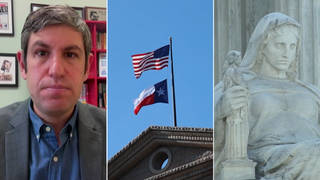
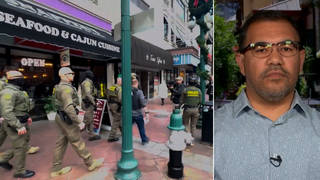
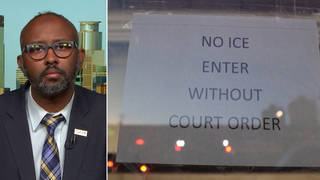
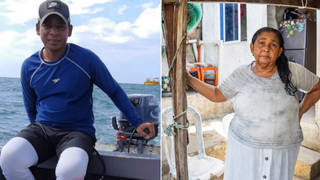





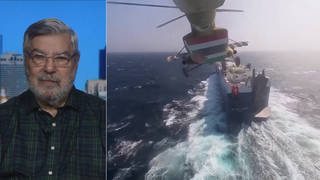

Media Options